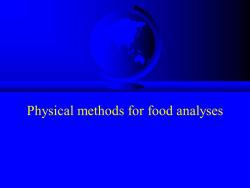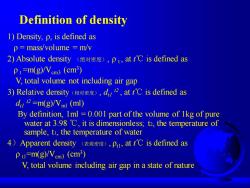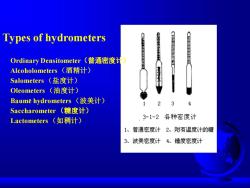华南理工大学:《食品分析》课程PPT教学课件(Food Analysis)Chapter 2 Physical Methods

Physical methods for food analyses
Physical methods for food analyses

Mehods 1) Densimetry(密度法) 2) Refractometry(折光法) 3) Polarimetry (旋光法) 4) Colourimetric method(色度) 5) Viscosimetry (粘度)
Mehods 1) Densimetry(密度法) 2) Refractometry(折光法) 3) Polarimetry (旋光法) 4) Colourimetric method (色度) 5) Viscosimetry (粘度)

Densimetry The density of many substances is a characteristic physical property and serves for identification purpose
Densimetry The density of many substances is a characteristic physical property and serves for identification purpose

Definition of density 1)Density,p,is defined as p mass/volume m/v 2)Absolute density(绝对密度),p,att℃is defined as Pt=m(g)/Vcm3 (cm) V,total volume not including air gap 3)Relative density(相对密度),d,P,at t'C is defined as du2=m(g)/Vml (ml) By definition,1ml =0.001 part of the volume of 1kg of pure water at 3.98 C,it is dimensionless;t2,the temperature of sample,ti,the temperature of water 4)Apparent density(表观度),P1,at t'C is defined as P t=m(g)/Vem3 (cm) V,total volume including air gap in a state of nature
1) Density, ρ, is defined as ρ = mass/volume = m/v 2) Absolute density (绝对密度), ρ t , at t℃ is defined as ρ t =m(g)/Vcm3 (cm3 ) V, total volume not including air gap 3) Relative density(相对密度), dt1 t2 , at t℃ is defined as dt1 t2 =m(g)/Vml (ml) By definition, 1ml = 0.001 part of the volume of 1kg of pure water at 3.98 ℃, it is dimensionless; t2, the temperature of sample, t1, the temperature of water 4)Apparent density (表观密度), ρt1, at t℃ is defined as ρ t1=m(g)/Vcm3 (cm3 ) V, total volume including air gap in a state of nature Definition of density

Influencing factor for density analyses 1)Temperature The density decreases by about 0.03%per C rise for the water at room temperature
Influencing factor for density analyses 1)Temperature The density decreases by about 0.03% per ℃ rise for the water at room temperature

Measurement of the density of liquids Pycnometric Method 1.Types of pycnometer (1)带毛细管的普通密度瓶(2)带温度计的精密密度瓶
Measurement of the density of liquids Pycnometric Method 1. Types of pycnometer

Principle: Measuring the weight of a known volume of liquid in a vessel,the volume of which was calibrated in terms of the weight of pure water that the vessel holds
Principle: Measuring the weight of a known volume of liquid in a vessel, the volume of which was calibrated in terms of the weight of pure water that the vessel holds

Matters need attention 1. Before use,the pycnometer must be thoroughly cleaned with a mixture of potassium dichromate and concentrated sulfuric acid,rinsed thoroughly with water,and dried. 2. To avoid changes in volume the pycnometer must not be subjected to excessive temperature or pressure changes. 3 Bubbles are the most common sources of relatively large errors
Matters need attention 1. Before use, the pycnometer must be thoroughly cleaned with a mixture of potassium dichromate and concentrated sulfuric acid, rinsed thoroughly with water, and dried. 2. To avoid changes in volume , the pycnometer must not be subjected to excessive temperature or pressure changes. 3. Bubbles are the most common sources of relatively large errors

Hydrometry (Archimedes principle) Based on the principle that the same body displaces equal weights of all liquids in which it floats.If V1 and V2 are the volumes of two liquids displaced by the same floating body,and D1 and D2 their respective densities,then V1D1 =V2D2 D1/D2=V2/V1 Thus,the volumes of different liquids displaced by the same floating body are inversely proportional to the densities of the liquids.If the floating body is an upright cylinder of uniform diameter,the volumes displaced are proportional to the depths (H1,H2)to which the body sinks. D1/D2=H2/H1
Hydrometry (Archimedes principle) Based on the principle that the same body displaces equal weights of all liquids in which it floats. If V1 and V2 are the volumes of two liquids displaced by the same floating body, and D1 and D2 their respective densities, then V1D1 =V2D2 D1/D2 = V2/V1 Thus, the volumes of different liquids displaced by the same floating body are inversely proportional to the densities of the liquids. If the floating body is an upright cylinder of uniform diameter, the volumes displaced are proportional to the depths (H1,H2) to which the body sinks. D1/D2 =H2/H1

Types of hydrometers Ordinary Densitometer(普通密度 Alcoholometers(酒精计) Salometers(盐度计) Oleometers(油度计) Baume hydrometers(波美计) 3 Saccharometer(糖度计) Lactometers(如稠计) 3-1-2各种密度计 1、普通密度计2、附有温度计的糖 3、波美密度计4、锤度密度计
Types of hydrometers Ordinary Densitometer(普通密度计) Alcoholometers (酒精计) Salometers (盐度计) Oleometers (油度计) Baumē hydrometers (波美计) Saccharometer (糖度计) Lactometers (如稠计)
按次数下载不扣除下载券;
注册用户24小时内重复下载只扣除一次;
顺序:VIP每日次数-->可用次数-->下载券;
- 华南理工大学:《食品分析》课程PPT教学课件(Food Analysis)Chapter 1 Introduction.ppt
- 华南理工大学:《食品分析》课程教学资源(PPT课件)13 实验方法评价与数据处理下载.ppt
- 华南理工大学:《食品分析》课程教学资源(PPT课件)12 分析质量保证.ppt
- 华南理工大学:《食品分析》课程教学资源(PPT课件)11 食品中有害物质的测定.ppt
- 华南理工大学:《食品分析》课程教学资源(PPT课件)10 食品中限量元素的测定.ppt
- 华南理工大学:《食品分析》课程教学资源(PPT课件)09 食品添加剂的测定.ppt
- 华南理工大学:《食品分析》课程教学资源(PPT课件)08 维生素的测定.ppt
- 华南理工大学:《食品分析》课程教学资源(PPT课件)07 蛋白质及氨基酸分析.ppt
- 华南理工大学:《食品分析》课程教学资源(PPT课件)06 脂类物质的测定.ppt
- 华南理工大学:《食品分析》课程教学资源(PPT课件)05 糖的测定.ppt
- 华南理工大学:《食品分析》课程教学资源(PPT课件)04 酸度的测定.ppt
- 华南理工大学:《食品分析》课程教学资源(PPT课件)03 灰分及矿物质元素.ppt
- 华南理工大学:《食品分析》课程教学资源(PPT课件)02 水分和水分活度的测定.ppt
- 华南理工大学:《食品分析》课程教学资源(PPT课件)01 绪论.ppt
- 上海交通大学:《食品安全学》课程教学大纲 Food Safety.pdf
- 《食品安全卫生原理》课程教学课件(PPT讲稿)第四章 化学性物质与食品安全.ppt
- 《食品安全卫生原理》课程教学课件(PPT讲稿)第二章 食品的污染、食源性疾病和食物中毒.ppt
- 《食品安全卫生原理》课程教学课件(PPT讲稿)第三章 生物性污染对食品安全的影响.ppt
- 《食品安全卫生原理》课程教学课件(PPT讲稿)第一章 食品的腐败与变质.ppt
- 《食品安全卫生原理》课程教学课件(PPT讲稿)绪论.ppt
- 华南理工大学:《食品分析》课程PPT教学课件(Food Analysis)Chapter 3 Water Activity.ppt
- 华南理工大学:《食品分析》课程PPT教学课件(Food Analysis)Chapter 4 Ash and Mineral.ppt
- 华南理工大学:《食品分析》课程PPT教学课件(Food Analysis)Chapter 5 Acidity.ppt
- 华南理工大学:《食品分析》课程PPT教学课件(Food Analysis)Chapter 6 Lipids.ppt
- 华南理工大学:《食品分析》课程PPT教学课件(Food Analysis)Chapter 7 Carbohydrates.ppt
- 华南理工大学:《食品分析》课程PPT教学课件(Food Analysis)Chapter 8 Amino Acid and Protein Analysis.ppt
- 华南理工大学:《食品分析》课程PPT教学课件(Food Analysis)Chapter 9 Vitamins Analysis.ppt
- 华南理工大学:《食品分析》课程PPT教学课件(Food Analysis)Chapter 10 Food Additves Analysis.ppt
- 华南理工大学:《食品分析》课程PPT教学课件(Food Analysis)Chapter 11 Trace Elements Analysis.ppt
- 华南理工大学:《食品分析》课程PPT教学课件(Food Analysis)Chapter 12 Reporting Results and Reliability of Analyses.ppt
- 华南理工大学:《食品分析》课程PPT教学课件(食品营养成分分析实验)实验一 食品中还原糖的测定.ppt
- 华南理工大学:《食品分析》课程PPT教学课件(食品营养成分分析实验)实验二 食品中淀粉的测定.ppt
- 华南理工大学:《食品分析》课程PPT教学课件(食品营养成分分析实验)实验三 食品中脂肪的测定.ppt
- 华南理工大学:《食品分析》课程PPT教学课件(食品营养成分分析实验)实验四 油脂中脂肪酸含量测定.ppt
- 华南理工大学:《食品分析》课程PPT教学课件(食品营养成分分析实验)实验五 食品中蛋白质含量测定.ppt
- 华南理工大学:《食品分析》课程PPT教学课件(食品营养成分分析实验)实验六 植物类食品中粗纤维的测定.ppt
- 华南理工大学:《食品分析》课程PPT教学课件(食品营养成分分析实验)实验七 食品中铅、镉、铬的测定.ppt
- 华南理工大学:《食品分析》课程PPT教学课件(食品营养成分分析实验)实验八 食品中维生素C的含量测定.ppt
- 华南理工大学:《食品分析》课程PPT教学课件(食品营养成分分析实验)实验十 食用植物油脂.ppt
- 华南理工大学:《食品分析》课程PPT教学课件(食品安全性检测实验)实验一 食品中亚硫酸盐含量测定.ppt
